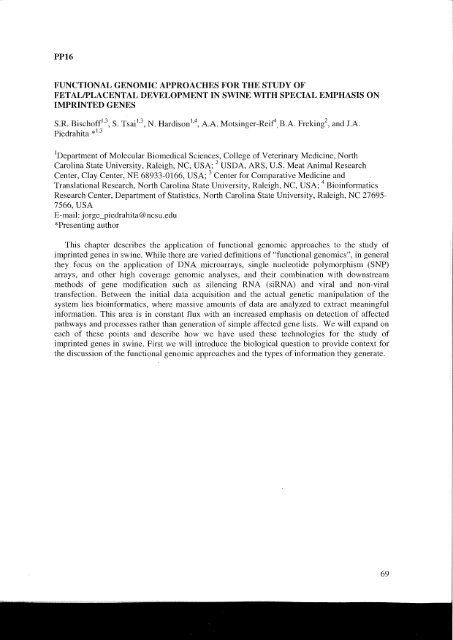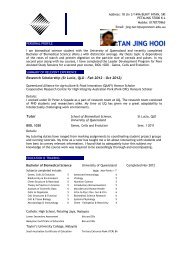Untitled - Pork CRC
Untitled - Pork CRC
Untitled - Pork CRC
Create successful ePaper yourself
Turn your PDF publications into a flip-book with our unique Google optimized e-Paper software.
PP16<br />
FUNCTIONAL GENOMIC APPROACHES FOR THE STUDY OF<br />
FETAL/PLACENTAL DEVELOPMBNT IN SWINE WITH SPECIAL EMPHASIS ON<br />
IMPRINTBD GENES<br />
S.R. Bischoffl'3, S. Tsair'3, N. Hardisont'0, A.A.Motsinger-Reif,g.R. Freking2, and J.A.<br />
Piedrahita *r'3<br />
rDepartment of Molecular Biomedical Sciences, College of Veterinary Medicine, North<br />
Carolina State University, Raleigh, NC, USA; 2 USDA, ARS, U.S. Meat Animal Research<br />
Center, Clay Center, NE 68933 -0|66,USA; 3 Center for Comparative Medicine and<br />
Translational Research, North Carolina State University, Raleigh, NC, USA;a Bioinformatics<br />
Research Center, Department of Statistics, North Carolina State University, Raleigh, NC 27695-<br />
7566, USA<br />
E-mail : jorge_piedrahita @ ncsu. edu<br />
*Presenting author<br />
This chapter describes the application of functional genomic approaches to the study of<br />
imprinted genes in swine. While there are varied definitions of "functional genomics", in general<br />
they focus on the application of DNA microarays, single nucleotide polymorphism (SNP)<br />
affays, and other high coverage genomic analyses, and their combination with downsÍeam<br />
methods of gene modification such as silencing RNA (siRNA) and viral and non-viral<br />
transfection. Between the initial data acquisition and the actual genetic manipulation of the<br />
system lies bioinformatics, where massive amounts of data are analyzed to extract meaningful<br />
information. This area is in constant flux with an increased emphasis on detection of affected<br />
pathways and processes rather than generation of simple affected gene lists. We will expand on<br />
each of these points and describe how we have used these technologies for the study of<br />
imprinted genes in swine. First we will introduce the biological question to provide context for<br />
the discussion of the functional genomic approaches and the types of information they generate.<br />
69



